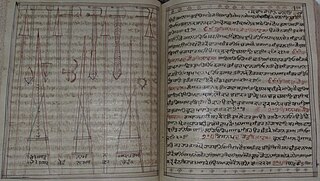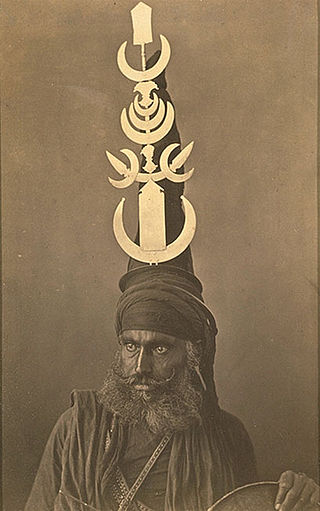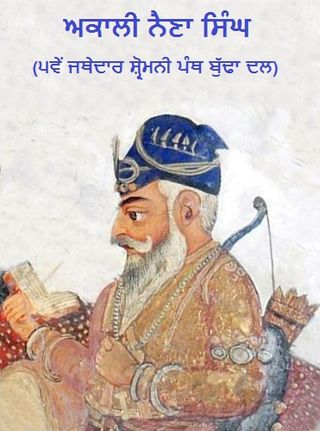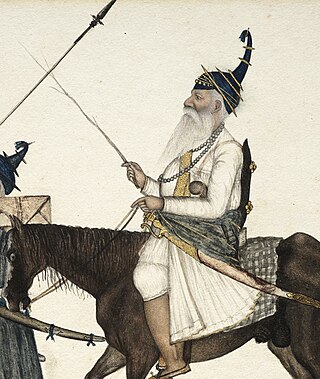| Part of a series on |
| Sikhism |
|---|
 |
The Nihang (Punjabi : ਨਿਹੰਗ) are an armed Sikh order. [1] They are also referred to as Akali (lit. "the immortals").
| Part of a series on |
| Sikhism |
|---|
 |
The Nihang (Punjabi : ਨਿਹੰਗ) are an armed Sikh order. [1] They are also referred to as Akali (lit. "the immortals").
Adherents of Sikhism follow a number of prohibitions. As with any followers of any faith or group, adherence varies by each individual.

The Nihang or Akali, also known as Dal Khalsa, is an armed Sikh warrior order originating in the Indian subcontinent. Nihangs are believed to have originated either from Fateh Singh and the attire he wore or from the "Akal Sena" started by Guru Hargobind. Early Sikh military history was dominated by the Nihang, known for their victories where they were heavily outnumbered. Traditionally known for their bravery and ruthlessness in the battlefield, the Nihang once formed the irregular guerrilla squads of the armed forces of the Sikh Empire, the Sikh Khalsa Army.

The Sarbloh Granth or Sarabloh Granth, also called Manglacharan Puran or Sri Manglacharan Ji, is a voluminous scripture, composed of more than 6,500 poetic stanzas. It is traditionally attributed as being the work of Guru Gobind Singh, the tenth Sikh guru. Scholars, on the other hand, attribute the work to after the Guru's death, being authored by an unknown poet. The work is mostly revered by the Nihang sect.

Fateh Singh, commonly referred to with honorifics as Baba Fateh Singh or Sahibzada Baba Fateh Singh, was the fourth and youngest son of Guru Gobind Singh.

Baba Deep Singh is revered among Sikhs as one of the most hallowed martyrs in Sikhism. He is remembered for his sacrifice and devotion to the teachings of the Sikh Gurus. Baba Deep Singh was the first head of Misl Shaheedan Tarna Dal – an order of the Khalsa military established by Nawab Kapur Singh, the then head of Sharomani Panth Akali Buddha Dal. The Damdami Taksal also state that he was the first head of their order.

The Sikh Khalsa Army, also known as Khalsaji or simply Sikh Army, was the military force of the Sikh Empire. With its roots in the Khalsa founded by Guru Gobind Singh, the army was later modernised on Franco-British principles by Maharaja Ranjit Singh. It was divided in three wings: the Fauj-i-Khas (elites), Fauj-i-Ain and Fauj-i-Be Qawaid (irregulars). Due to the lifelong efforts of the Maharaja and his European officers, it gradually became a prominent fighting force of Asia. Ranjit Singh changed and improved the training and organisation of his army. He reorganized responsibility and set performance standards in logistical efficiency in troop deployment, manoeuvre, and marksmanship. He reformed the staffing to emphasize steady fire over cavalry and guerrilla warfare, improved the equipment and methods of war. The military system of Ranjit Singh combined the best of both old and new ideas. He strengthened the infantry and the artillery. He paid the members of the standing army from treasury, instead of the Mughal method of paying an army with local feudal levies.

The khanda is a double-edge straight sword originating from the Indian subcontinent. The Rajput warrior clans venerated the khanda as a weapon of great prestige. It is often featured in religious iconography, theatre and art depicting the ancient history of India. It is a common weapon in Indian martial arts. Khanda often appears in the Sikh, Jain, Buddhist and Hindu scriptures and art.

Bidhi ChandChhina was a Sikh religious preacher and military commander, from Chhina Bidhi Chand village, 37 kilometers south of Amritsar and Chhina Bidhi Chand was part of Amritsar District not Lahore. His birth place temple is situated in his own village Chhina Bidhi Chand, which was built by the residents with the help of Baba Daya Singh. Baba Daya Singh laid foundation with his own hands. Every year on his birthday Baba Daya Singh, and now Baba Avtar Singh, would go to village Chhina Bidhi Chand and celebrate it there to date. He was a disciple of Guru Arjan and served Guru Hargobind for most of his life.

The Shaheedan Misl, also known as the Shahid Misl, was one of twelve Sikh Misls that later became the Sikh Empire. It held a small amount of territory in the Malwa (Punjab) area around the Damdama Sahib before being incorporated into the Sikh Empire of the Sukerchakia Misl by Ranjit Singh.

Akali Phula Singh Nihang was an Akali Nihang Sikh leader. He was a saint soldier of the Khalsa Shaheedan Misl and head of the Budha Dal in the early 19th century. He was also a senior general in the Sikh Khalsa Army and commander of the irregular Nihang of the army. He played a role in uniting Sikh misls in Amritsar. He was not afraid of the British who at many times ordered for his arrest but were not successful. During his later years he served for the Sikh Empire as a direct adviser to Maharaja Ranjit Singh. He remained an army general in many famous Sikh battles up until his martyrdom in the battle of Nowshera. He was admired by the local people and had a great influence over the land and his settlement was always open to help the poor and helpless. He was well known and was a humble unique leader and prestigious warrior with high character. He was also known for his effort to maintain the values of Gurmat and the Khalsa panth.

Dastar bunga, or "towering fortress", is a style of turban used by a specific sect within the Sikhs, the Akali Nihangs. As an essential part of their faith the warriors used the turban as a store for their expansive range of weapons.

Baba Hanuman Singh, also known as Akali Hanuman Singh or Amar Shaheed Baba Hanuman Singh, was a Nihang Sikh and was the 7th Jathedar of Budha Dal and Jathedar of Akal Takhat. He was the successor of Akali Phula Singh. He was the first one who fought against the British. He attained martyrdom during a battle with the British and Patiala State in 1846.

Naina Singh, also known as Narayan Singh, was a Nihang warrior and fifth Jathedar of Budha Dal and a chief of the Shaheedan Misl during the late 18th century.

Akali Kaur Singh Nihang was a religious preacher and Sikh scholar.

Baba Prahlad Singh was a Nihang Sikh and 8th Jathedar of Shiromani Panth Akali Budha Dal.

Pashaura Singh (1928–2008) also known as Santa Singh or to Nihang Sikhs as Jathedar Akali Baba Santa Singh Ji Nihang 96 Crori was the 13th Jathedar of Budha Dal, succeeding Akali Chet Singh.

In Sikhism, some Sikhs particularly of the Nihang community use edible cannabis in a religious context. They make use of cannabis by ingestion. It is used to make a drink called "Shaheedi Degh" which is meant to help Nihang Singhs become highly present in the moment. Nihang Singhs used marijuana in the early times of Sikh history during times of battle, it is believed to help them become more fierce warriors.
Surjit Singh (1945–2014) or Jathedar Surjeet Singh Akali was a Nihang and the 14th Jathedar of Budha Dal, after Akali Santa Singh. He was born on June 7, 1945, in Murar, Amritsar.
Joginder Singh, or Baba Joginder Singh is a Nihang Singh and is claimed to be 15th Jathedar of Budha Dal after Akali Surjit Singh. He was born in Boparai Kalan, Ludhiana.
Khalsa bole is a bravado-based language variety developed and spoken by members of the Akali-Nihang sect of Sikhism. It has also been described as a coded language. Sant Singh Sekhon describes the lect as a "grandiloquent patois" that "comprises euphemisms and jargon symbolic of high-spirited confidence and courage".